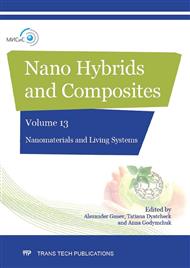[1]
I.V. Antoniac (ed. ), Handbook of Bioceramics and Biocomposites, Springer, 2015. 1386 p.
Google Scholar
[2]
B. Attaf (ed. ), Advances in composite materials for medicine and nanotechnology, In Tech, 2011. 648 р.
Google Scholar
[3]
E.P. Ivanova, K. Bazaka, R.J. Crawford, New functional biomaterials for medicine and healthcare, Wood head Pub., 2014. 226 p.
Google Scholar
[4]
P.X. Ma (ed. ), Biomaterials and Regenerative Medicine, Cambridge University Press, 2014. 704 p.
Google Scholar
[5]
B.J. McEntire, B.S. Bal, M.N. Rahaman, J. Chevalier, G. Pezzotti, Ceramics and ceramic coatings in orthopaedics, Journal of the European Ceramic Society, 35(16) (2015) 4327-4369.
DOI: 10.1016/j.jeurceramsoc.2015.07.034
Google Scholar
[6]
K. Bodisova, P. Sajgalik, D. Galusek, P. Svancarek, Two-stage sintering of alumina with submicrometer grain size, J. Am. Ceram. Soc. 90 (2006) 330-332.
Google Scholar
[7]
W.C. Oliver, G.M. Pharr, Measurement of hardness and elastic modulus by instrumented indentation: advances in understanding and refinements to methodology, J. Mater. Res. 19 (2004) 3–20.
DOI: 10.1557/jmr.2004.19.1.3
Google Scholar
[8]
C.B. Ponton, R.D. Rawlings, Vickers indenta-tion fracture toughness test Part 1 Review of litera-ture and formulation of standardised indentation toughness equations, Materials Science and Tech-nology. 5 (1989) 865-872.
DOI: 10.1179/mst.1989.5.9.865
Google Scholar
[9]
C.B. Ponton, R.D. Rawlings, Vickers indenta-tion fracture toughness test Part 2 Application and critical evaluation of standardised indentation toughness equations, Materials Science and Tech-nology. 5 (1989) 961-976.
DOI: 10.1179/mst.1989.5.10.961
Google Scholar
[10]
B.R. Lawn, A.G. Evans, D.B. Marshall, Elastic/plastic indentation damage in ceramics: the me-dian/radial crack system, Journal of the American Ceramic Society. 63 (1980) 574-581.
DOI: 10.1111/j.1151-2916.1980.tb10768.x
Google Scholar
[11]
Yu.I. Golovin, A.I. Tyurin, Nondislocation plasticity and its role in the mass transfer and formation of the indentation under dynamic conditions, Physics of the Solid State. 42(10) (2000) 1865-1867.
DOI: 10.1134/1.1318878
Google Scholar
[12]
Yu.I. Golovin, A.I. Tyurin, V.I. Ivolgin, V.V. Korenkov, Dynamic characteristics of solids in microvolumes: modern principles, techniques, and results of investigation, Technical Physics. The Russian Journal of Applied Physics. 45(5) (2000).
DOI: 10.1134/1.1259684
Google Scholar
[13]
L. Melk, M. Turon-Vinas, J.J. Roa, M.L. Antti, M. Anglada, The influence of unshielded small cracks in the fracture toughness of yttria and of ceria stabilised zirconia, Journal of the European Ceramic Society. 36 (2016) 147-153.
DOI: 10.1016/j.jeurceramsoc.2015.09.017
Google Scholar
[14]
A. Nastic, A. Merati, M. Bielawski, M. Bolduc, O. Fakolujo, M. Nganbe, Instrumented and Vickers Indentation for the Characterization of Stiffness, Hardness and Toughness of Zirconia Toughened Al2O3 and SiC Armor, Journal of Materials Science & Technology. 31 (2015).
DOI: 10.1016/j.jmst.2015.06.005
Google Scholar
[15]
H. Miyazaki, Y.I. Yoshizawa, Correlation of the indentation fracture resistance measured using high-resolution optics and the fracture toughness obtained by the single edge-notched beam (SEPB) method for typical structural ceramics with various microstructures, Ceramics International. 42 (2016).
DOI: 10.1016/j.ceramint.2016.01.116
Google Scholar
[16]
V.S. Stubican, S.P. Ray, Phase Equilibria and Ordering in the System ZrO2-CaO, J. Am. Ceram. Soc. 60 (1977) 534-537.
DOI: 10.1111/j.1151-2916.1977.tb14100.x
Google Scholar
[17]
K. Wang, C.H. Li, Y.H. Gao, X.G. Lu, W.Z. Ding, Thermodynamic reassessment of ZrO2-CaO system, J. Am. Ceram. Soc. 92 (2009) 1098-1104.
Google Scholar
[18]
S. Serena, M.A. de Aza S. Sainz, A. Caballero, Thermodynamic assessment of the system ZrO2–CaO–MgO using new experimental results: Calculation of the isoplethal section MgO×CaO-ZrO2, J. Europ. Ceram. Soc. 25 (2005) 681-694.
DOI: 10.1016/s0955-2219(04)00077-9
Google Scholar
[19]
Y. Yin, B. Argent, Phase diagrams and thermodynamics of the systems ZrO2-CaO and ZrO2-MgO, J. Phase Equilib. 14 (1993) 439-450.
DOI: 10.1007/bf02671962
Google Scholar


